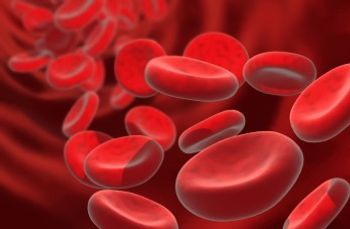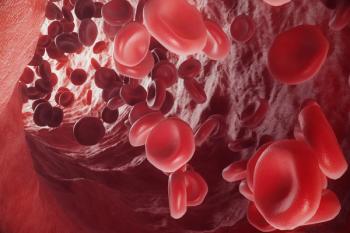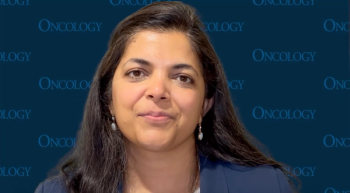
Chemoradiation/SABR Yields Notable Safety, Efficacy in Small NSCLC Cohort
Adding adaptive radiation to chemotherapy may offer a novel approach to treating patients with advanced non–small cell lung cancer, according to Michael Steinberg, MD.
Combining hypofractionated concurrent chemoradiotherapy with adaptive stereotactic ablative radiotherapy (SABR) resulted in promising efficacy and tolerability among a small cohort of patients with locally advanced, unresectable non–small cell lung cancer (NSCLC), according to findings from an early-phase study (NCT01345851) published in JAMA Oncology.1
Investigators reported a median overall survival (OS) of 25.9 months among all patients, including pooled 1-year and 2-year rates of 78.6% and 52.5%, respectively. The pooled local control rates were 90.8% at 1 year and 85.7% at 2 years. Additionally, the median progression-free survival (PFS) across the entire population was 9.8 months; the collective 1-year and 2-year PFS rates were 35.1% and 22.0%, respectively.
The 2-year OS rate was 30.0% for those who received a low-dose SABR boost, 76.2% for those who received an intermediate-dose boost, and 55.6% for patients treated with a high-dose boost. The 2-year local control rates in the low-, intermediate-, and high-dose groups, respectively, were 74.1%, 85.7%, and 100.0%. Additionally, the 2-year PFS rates in each respective group were 0.0%, 37.5%, and 25.4%.
“This study contributes to ongoing efforts to improve the treatment of lung cancer, a leading cause of cancer-related death,” senior author Michael Steinberg, MD, professor and chair of radiation oncology at the David Geffen School of Medicine and director of Clinical Affairs at the University of California Los Angeles (UCLA) Health Jonsson Comprehensive Cancer Center, said in a press release on these findings.2 “The integration of adaptive radiation with chemotherapy offers a novel approach that shows promise in terms of safety, effectiveness, and improved patient outcomes, paving the way for more effective and personalized treatments.”
Investigators of this single-institution radiation dose-escalation trial assessed outcomes with hypofractionated chemoradiotherapy plus SABR in patients with stage II or III NSCLC.1 All patients received radiation at 4 Gy in 10 fractions followed by an adaptive SABR boost to residual disease. Patients received the boost at one of several doses including 25 Gy (low dose; n = 10), 30 Gy (intermediate dose; n = 9), or 35 Gy (high dose; n = 9) plus concurrent carboplatin and paclitaxel doublet chemotherapy.
The trial’s primary end point was the maximum tolerated dose (MTD). Secondary end points included local control, PFS based on RECIST v1.1 criteria, and OS.
Patients 18 years and older with a Karnofsky performance status of 70 or higher were able to enroll on the trial. Those who received prior thoracic radiotherapy or had an active infection that needed to be managed with antibiotic treatment were unable to enroll.
The median patient age was 70 years (range, 51-88), and most patients were male (57%). Overall, most patients had adenocarcinoma (64%), no oncogenic mutation status (61%), and stage IIIA disease (50%). Investigators reported no statistically significant differences in initial internal target volume (iITV), initial planning target volume (PTV1), or boost ITV (bITV) across the different boost-dose groups.
Nonhematologic acute grade 3 or higher toxicities occurred in 11% of patients, and late high-grade toxicities affected 7%. Investigators observed no grade 4/5 toxicities among patients in the low-dose group and no grade 3 or higher toxicity in the intermediate-dose group. Treatment-related deaths occurred in 7% (n = 2) of patients, both of whom were in the high-dose group.
Late grade 1/2 toxicity occurred in 63% of patients. Additionally, the MTD was not reached, and dose-limiting toxicities were limited in each dose-escalation group.
“Our field has been moving towards hypofractionation across many disease sites; however, it is particularly challenging in locally advanced lung cancer due to the close vicinity of tumor to sensitive structures such as the airways and esophagus,” lead study author Trudy Wu, MD, a radiation oncology resident at UCLA, said in the press release.2 “Using a novel adaptive boost technique personalized to an individual’s treatment response after the first two-thirds of radiation treatment allows for a tighter conformal radiation boost plan and reduction of healthy tissue receiving radiation.”
References
- Wu TC, Luterstein E, Neilsen BK, et al. Accelerated hypofractionated chemoradiation followed by stereotactic ablative radiotherapy boost for locally advanced, unresectable non–small cell lung cancer: a nonrandomized controlled trial. JAMA Oncol. Published January 11, 2024. doi:10.1001/jamaoncol.2023.6033
- High-dose radiotherapy with chemotherapy effective in treating people with non-small cell lung cancer. News release. University of California Los Angeles Health. January 11, 2024. Accessed January 12, 2024. https://shorturl.at/aBU01
Newsletter
Stay up to date on recent advances in the multidisciplinary approach to cancer.

















































































